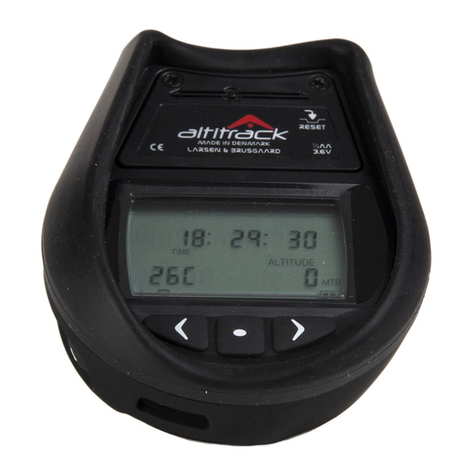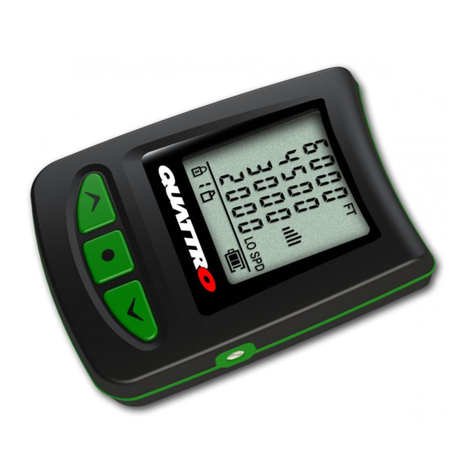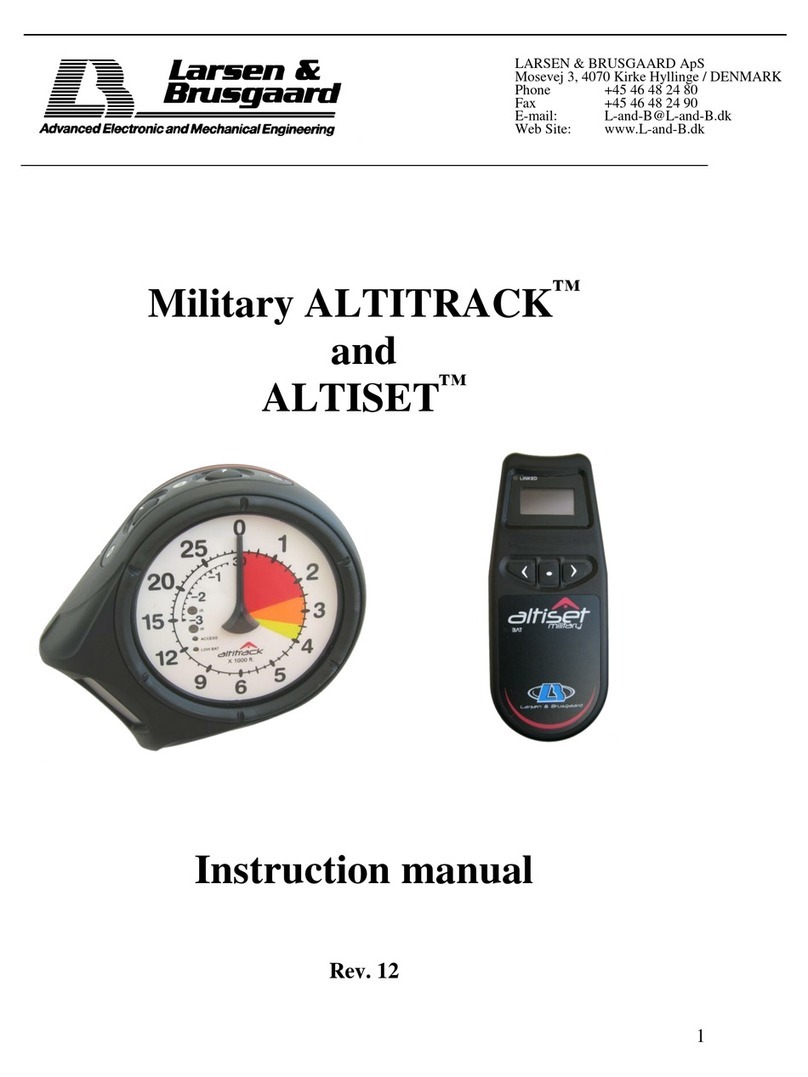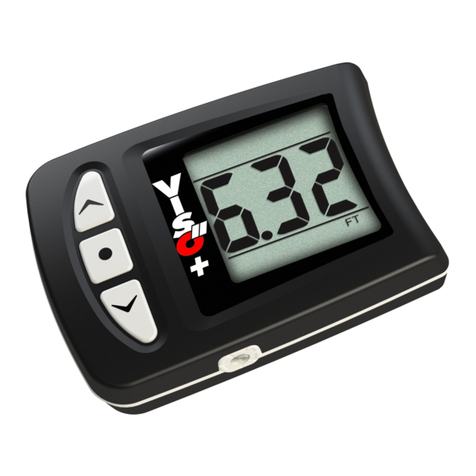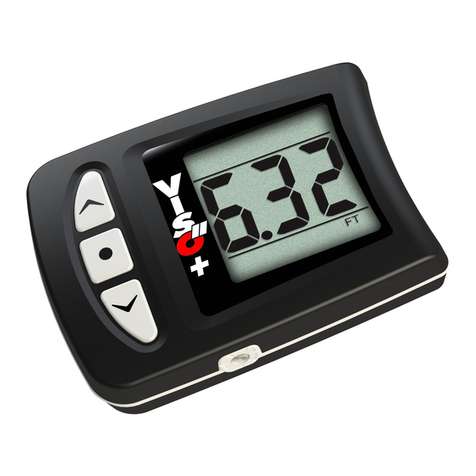Canopy Descent and
Low Speed Warnings Selector
Description
The OPTIMA II includes two types of warning sounds which
can be selected to sound while under canopy descent or
during wing suit flight.
1. Canopy Descent and Low Speed Warnings:
Short beeps sound when passing through one, two or three
selectable altitudes during canopy descent or wing suit
flight.
2. Guide Tones:
A unique series of guide beeps sound when flying from
the 2nd through the 3rd selected Canopy Descent Warning
altitudes.
Setting Canopy Descent and Low Speed Warnings
Note: Minimum selectable height is 100 ft (30 meters)
Note: Default values 1200 ft., 900 ft., and 600 ft. have been
factory preset for Canopy Descent Warning altitudes.
In the Main Display mode, press to access the Canopy
Descent and Low Speed Warnings Selector.
Warning Bank Menu Functions
The OPTIMA II has 4 canopy descent and low speed warning
banks. When the warning bank icon is flashing, press or to
select warning bank 1 to 4.
Setting the Warning Alarm Altitudes
The setting of altitudes in each warning bank can be perfor-
med either on the ground or in the airplane during climb to
jump altitude.
Three Warning Alarms
1. Press until 1st warning altitude flashes
2. Press or to change 1st warning altitude
3. Press again and the 2nd warning altitude flashes
4. Press or to change 2nd warning altitude
5. Press again and the 3rd warning altitude flashes
6. Press or to change 3rd warning altitude
Two Warning Alarms
If you choose, you may have only two warning alarms. The
procedure is the same as above, but choose same altitude for
the two highest warning alarms (the OPTIMA II then sounds
only the 2nd and 3rd warning alarms).
One Warning Alarm
If you wish only one warning alarm, choose same altitude
for all three warning alarms using the above procedure. (The
unit sounds only the 3rd warning alarm).
Sound Pitch
Press again. The musical note icon and pitch bar graph
will begin to flash
Press or to change the pitch up or down. The pitch
bar graph will display the number of bars corresponding to
the selected pitch and the selected pitch will sound.
NOTE: When selecting a pitch on either side of the center vertical
bar (3,800 Hz), the output volume decreases about 5 dB because
the speaker is no longer at its optimum resonance frequency.
Sound Volume
Press or to select output volume.
”1” is very low volume (112 dB), ”10” is very high volume
(117 dB)
The OPTIMA II is factory preset to ”3”.
NOTE: In case of low capacity the volume will automatically
switch to ”1” and it cannot be changed until the batteries
have been replaced.
Setting Guide Tones
Explanation:
When Guide Tones are activated, a unique series of beeps
sound between the 2nd and 3rd Canopy Descent Warning
altitudes.
The series of beeps can be compared to an aircraft ILS ap-
proach. The first beep sounds when passing through the 2nd
warning altitude, the next beep 30% into the glide corridor,
then after 55% and so on as depicted in the diagram. The
diagram shows an example where the 2nd warning is set to
1,500 ft and the 3rd warning to 300 ft. A long beep sounds
when passing through the 3rd selected altitude. The steeper
a glide angle the shorter time between beeps.
NOTE: For safety reasons, the minimum selectable swoop height is
100 ft.(30 meter) and the minimum selectable altitude difference
between the 2nd and the 3rd warnings is 300 ft.(90 meters).
To enable Guide Tones
NOTE: Before enabling Guide Tones, the minimum altitude
difference between the 2nd and the 3rd warnings must be 300
ft. (90 meters)
Press repeatedly until GUIDE flashes. Press or
until the GUIDE icon is on.
NOTE: When Guide Tones are enabled, the GUIDE icon will show
in the warning bank area of all warning bank displays and in the
Main Display.
To disable Guide Tones
Press repeatedly until GUIDE flashes. Press or
until the GUIDE icon is off.
NOTE: When Canopy Descent and Low Speed Warnings are enabled,
the LO SPD icon will show in the warning bank area of all warning
bank displays and in the Main Display. To disable LO SPD, first
disable Guide Tones, then set all warnings to ---
Test Alarm Sounds
Press again. The ”Ear” icon will begin to flash. Press
or . This causes the OPTIMA to sound the preset alarm
sequence at the selected pitch.
NOTE: When GUIDE is enabled, a series of beeps sound which
simulates a 10m/sec canopy descent and when GUIDE is disabled,
three warning beeps sound
Climb to Altitude Warnings and Clock
Selector
The altitude during climb at which the beep is heard may be
changed or up to three different altitudes during climb may
be selected for beep sounds.
At the lowest preset altitude (factory preset to 1,000 feet),
the OPTIMA II sounds a sequence of beeps. These beeps
have two functions:
1. The beeps indicate that the OPTIMA II has calibrated
itself to the local ground elevation and is ready to jump.
2. The number of beeps indicates the altitude at which the
highest warning alarm is set; for example: If set to 4,500
feet, the signal will sound: beep-beep-beep-beep-(pause)-
beep. The number of rapid-sequence of beeps indicates the
highest warning altitude in thousands of feet. The beep after
a pause (if any), signifies a 500-foot altitude increment.
Should the battery voltage of the OPTIMA II show low capa-
city, the beep sequence is followed by 5 short beeps. This
indicates that the batteries should be replaced.
NOTE: At the same time the output volume setting is automatically
changed to low volume “1” and it cannot be changed until the
batteries have been replaced.
When the aircraft begins climbing to altitude, the OPTIMA II
displays the current altitude at the top of the display.
Setting Climb to Altitude Warnings
The setting of warning altitudes can be performed either on
the ground or in the airplane during climb to jump altitude.
Three Warning Alarms
1. Press until 1st warning altitude flashes
2. Press or to change 1st warning altitude
3. Press again and the 2nd warning altitude flashes
4. Press or to change 2nd warning altitude
5. Press again and 3rd warning altitude flashes
6. Press or to change 3rd warning altitude
Sequence of Climb Warning Alarm Altitudes
You may note that when setting the warning altitudes, it is
possible to set the 1st warning alarm altitude lower than the
second or even the 3rd warning altitudes. The 2nd warning
altitude could be set to a higher value than the 1st warning
altitude or a lower value than the 3rd warning altitude, and
so on. This is not a problem – when the OPTIMA II exits
ACCESS mode, it will automatically sort and store the war-
ning alarms such that the highest warning altitude become
the 1st warning alarm, the next highest warning altitude
becomes the 2nd warning alarm, and the lowest warning
altitude becomes the 3rd warning alarm.
One or Two Warning Alarms
If you wish only one warning alarm or two alarms, preset the
not used alarm(s) to ---
Time Set Function
Built-in clock
In Main Display mode, press to display the time. The time
is in 24-hour format. The time is displayed for 15 seconds
and then reverts back to the Main Display.
Setting the time:
Perform ACCESS and press repeatedly until “clock” flashes.
Then press or to set the time.
OPERATIONAL CONSIDERATIONS
Prior to Jumping
The OPTIMA II continually adjusts to the local elevation
and displays 0 FT (MT) at the top of the display. If the top
of the display does not show “0” (or your selected altitude
offset) prior to jumping, the unit has not adjusted itself to
the local elevation and it must be manually zeroed. See the
section, “Altitude Offset Function” under Menu functions
above. Even when the display turns OFF, the unit is still
ready for jumping
Setting an Altitude Offset
If the drop zone (DZ) elevation is different from that of the
take-off airport, you may compensate for this difference by
setting an Altitude Offset – see the Altitude Offset menu
function described above.
Battery Status
Full capacity: Symbol shows two black bars inside the bat-
tery icon.
Half capacity: Symbol shows one black bar inside the battery
icon.
Low capacity: Symbol shows no black bars, just an “empty”
battery icon. Batteries should be replaced as soon as pos-
sible. As a reminder, 5 short beeps sound when climbing
through the lowest preset climb altitude. At the same time
the output volume setting is automatically changed to low
volume “1”.
Empty batteries: The battery icon flashes. Replace batteries
immediately.
Mounting the OPTIMA II
The OPTIMA II can be mounted on the outside of the helmet
or on a Goggle Mount.
Loop the waxed tack cords through the four mounting holes
and fasten with knobs to the helmet/Goggle Mount
NOTE: Make sure that there is no material between the OPTIMA II
loudspeaker hole and your ear.
Resetting the OPTIMA II
Press a paperclip into the tiny hole on the rear side of the
unit and release. The unit restarts.
NOTE: Reset the unit after battery replacement, when troubleshoo-
ting and when verifying software version number.
Air Filter
The OPTIMA II is water resistant.
The Air Filter is the white circular part mounted on the side
of the unit. If it becomes wet (after a splash in the swoop
pond) then let the OPTIMA II dry in a warm place for 48
hours.
NOTE: The Air Filter must be replaced if jumping is resumed quickly
or if the OPTIMA II has been submerged into water.
Air Filter removal tooling kit is an accessory which can be
purchased separately.
OPTIMA II Firmware Version
Perform reset. The version number is displayed at the upper
part of the screen (altitude area). The numbers displayed in
the middle of the screen is a factory reference number.
Battery replacement
Carefully remove screw from battery cover and remove
batteries.
Install new batteries and note polarity.
Use only CR-2325 or equivalent.
NOTE: Reset the OPTIMA II after replacing batteries.
Customer settings are kept in non-volatile memory when
removing batteries. However, the built-in clock may again be
set to the correct time.
Trouble-shooting
When the OPTIMA II detects a fault, an error (“ERR”) sign
and trouble shooting number 2 to 4 are displayed in the
upper part of the screen. At the same time the unit beeps
every minute.
The “ERR” trouble shooting codes are as follows:
ERR 2, ERR 3, ERR 4 = unit is defective. Remedy: perform
reset
If the unit does not function correctly even after replacing
batteries and pressing reset, perform following:
Press and hold while resetting.
The OPTIMA II resets to factory settings and sounds three
beeps.
If the unit is still faulty, please contact your local dealer or
LARSEN & BRUSGAARD.
SPECIFICATIONS
Dimensions: 52 x 40 x 12 mm
(2.16 x 1.57 x 0.47 inches)
Weight: 26 grams (0.9 oz.)
Battery type: 2 x CR 2325 or equivalent
Battery Life Time: 2.5 years or 500 jumps
Freefall alarm sounds:
1st warning:
One 3 second pulsating alarm if vertical airspeed exceeds 13 m/
sec at preset altitude. Sound sequence: Pulsating, low repetition.
2nd warning:
One 4 second pulsating alarm if vertical airspeed exceeds
13 m/sec at preset altitude. Sound sequence: Pulsating, high
repetition.
3rd warning:
Siren alarm as long as vertical airspeed exceeds 13 m/sec at
or below the preset altitude. After deployment the trigger
speed switches to 35 m/sec. Sound sequence: High pitch
continuous siren.
Low Speed alarm sounds:
1st warning: One 0.2 second beep
2nd warning: Two 0.2 second beeps
3rd warning: One 1.3 second beep
Climb to Altitude Warnings: Two 0.2 second beeps
Alarm output volume: 112 dB at maximum pitch
117 dB at minimum pitch
Freefall alarm calibration range: 1,000 to 9,990 feet (30 to
3,330 meters)
Low speed alarm calibration range: 100 to 9,990 feet (90 to
3,330 meters)
Minimum Climb to Altitude setting: 1,000 ft. (300 meters)
Altitude selection interval: 10 feet (10 meters)
Operating altitude: 0 to 40,000 feet
Accuracy: ± 20 feet (+/- 6 meters) at MSL
Operating Temperature Range: -20° C to +50° C (-4° F to
+122° F)
Meets or exceeds EEC/89/336
L&B part no.: 205222
NATO Stock no.: 6605-22-609-1694

